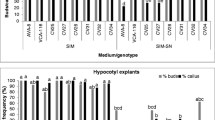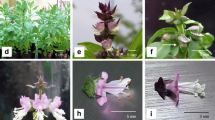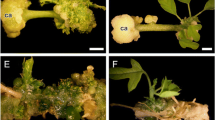Abstract
In vitro regeneration of sweet pepper (Capsicum annuum L. cvs Jupiter and Pimiento Perfection) has been performed via direct organogenesis. The resulting shoot-buds were placed on media containing 24-epi-brassinolide (EBR) 0.1 μM, a plant steroid lactone, in the presence or absence of zeatin 9.1 μM plus GA3 5.2 μM for further stem elongation. Different responses to these treatments were recorded depending upon the protocols used and the genotypes tested. It appears that EBR does not always act directly on stem elongation but may be an elicitor and/or an enhancer of elongation in concert with endogenous and other exogenously added growth regulators. Elongated shoots were easily rooted with alpha-naphtalenacetic acid 0.5 μM (0.1 mgl-1) and transfered to soil, and following acclimation were taken to maturity in the greenhouse.
Similar content being viewed by others
References
Agrawal S, Chandra N & Kothari SL (1989) Plant regeneration in tissue cultures of pepper (Capsicum annuum L. cv. Mathania). Plant Cell Tiss. Org. Cult. 16: 47–55
Arroyo R & Revilla MA (1991) In vitro plant regeneration from cotyledon and hypocotyl segments in two bell pepper cultivars. Plant Cell Rep. 10: 414–416
Clouse SD (1996) Molecular genetic studies confirm the role of brassinosteroids in plant growth and development. Plant J. 10: 1–8
Clouse SD & Zurek DM (1991) Molecular analysis of brassinolide action in plant growth and development. In: Cutler, HG, Yokoda, T, Adam, G (eds) Brassinosteroids; Chemistry, Bioactivity and Applications, ACS Symposium Series 474 (122–140). American Chemical Society. Washington DC.
Clouse SD, Zurek DM, Mc Morris TC & Baker ME (1992) Effect of brassinolide on gene expression in elongating soybean epicotyls. Plant Physiol. 100: 1377–1383
Fari M & Csako M (1981) Relationship between position and morphogenetic response of pepper hypocotyl explants cultured in vitro. Sci. Hort. 15: 207–213
Gamborg OL, Miller RA & Ojima K (1968) Nutrient requirements of suspension cultures of soybean root cells. Exp. Cell Res. 50: 151–158
Gaudinova A, Sussenbekova H, Vojtechova M, Kaminek M, Eder J & Kohout L (1995) Different effects of two brassino steroids on growth, auxin and cytokinin content in tobacco callus tissue. Plant Growth Reg. 17: 121–126
Gregory LE & Mandava NB (1982) The activity and interaction of brassinolide and gibberellic acid in mung bean epicotyls. Physiol. Plant. 54: 239–243
Gunay AL & Rao PS (1978) In vitro plant regeneration from hypocotyl and cotyledon explants of red pepper. Plant Sci. Lett. 11: 365–372
Hyde CL & Phillips GC (1996) Silver nitrate promotes shoot development and plant regeneration of chile pepper (Capsicum annuum L.) via organogenesis. In Vitro Cell. Dev. Biol. 32: 72–80
Katsumi M (1985) Interaction of a brassinosteroid with IAA and GA3 in the elongation of cucumber hypocotyl sections. Plant Cell Physiol. 26: 615–625
Kauschmann A, Jessop A, Koncz C, Szekeres M, Willmitzer L & Altmann T (1996) Genetic evidence for an essential role of brassinosteroids in plant development. Plant J. 9: 701–713
Mandava NB, Sasse JM & Yopp JH (1981) Brassinolide, a growth-promoting steroidal lactone. II. Activity in selected gibberrellin and cytokinin bioassays. Physiol. Plant. 53: 453–461
Mandava NB (1988) Plant growth-promoting brassinosteroids. Annu. Rev. Plant Physiol. Plant Mol. Biol. 39: 23–52
Mayumi K & Shibaoka H (1995) A possible double role for brassinolide in the reorientation of cortical microtubules in the epidermal cells of Azuki bean epicotyls. Plant Cell Physiol. 36: 173–181
Murashige T & Skoog F (1962) A revised medium for rapid growth and bioassays of tobacco tissue cultures. Physiol. Plant. 15: 473–497
Ochoa-Alejo N & Ireta-Moreno L (1990) Cultivar differences in shoot forming capacity of hypocotyl tissues of chilli pepper (Capsicum annuum L.) cultured in vitro. Sci. Hort. 42: 21–28
Phillips GC & JF Hubstenberger (1985) Organogenesis in pepper tissue cultures. Plant Cell Tiss. Org. Cult. 4: 261–269
Sakurai A & Fujioka S (1993) The current status of physiology and biochemistry of brassinosteroids. Plant Growth Reg. 13: 147–159
Sasse JM (1985) The place of brassinolide in the sequential response to plant growth regulators in elongating tissue. Physiol. Plant. 63: 303–308
Sasse JM (1990) Brassinolide-induced elongation and auxin. Physiol. Plant. 80: 401–408
Sripichitt P, Nawata E & Shigenaga S (1987) In vitro shoot forming capacity of cotyledon explants in red pepper (Capsicum annuum L. cv. Yatsufusa). Jpn. J. Breed. 37: 133–142
Subhash K & Christopher T (1988) Direct plantlet formation in cotyledon cultures of Capsicum frutescens. Curr. Sci. 57: 99–100
Szasz A, Nervo G & Fan M (1995) Screening for in vitro shoot-forming capacity of seedling explants in bell pepper (Capsicum annuum L.) genotypes and efficient plant regeneration using thidiazuron. Plant Cell Rep. 14: 666–669
Valera-Montero LL & Ochoa-Alejo N (1992) A novel approach for chili pepper (Capsicum annuum L.) plant regeneration: shoot induction in rooted hypocotyls. Plant Sci. 84: 215–219
Wang Y, Yang M, Pan N & Chen Z (1991) Plant regeneration and transformation of sweet pepper (Capsicum frutescens). Acta Bot. Sin. 33: 780–786
Author information
Authors and Affiliations
Rights and permissions
About this article
Cite this article
Franck-Duchenne, M., Wang, Y., Ben Tahar, S. et al. In vitro stem elongation of sweet pepper in media containing 24-epi-brassinolide. Plant Cell, Tissue and Organ Culture 53, 79–84 (1998). https://doi.org/10.1023/A:1006071803855
Issue Date:
DOI: https://doi.org/10.1023/A:1006071803855




